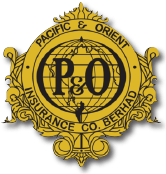
Fitch Affirms Pacific & Orient Insurance's 'BBB+' IFS Rating; Outlook Stable
Fitch Ratings - Singapore/Hong Kong - 23 Sep 2022: Fitch Ratings has affirmed Pacific & Orient Insurance Co. Berhad's (POI) Insurer Financial Strength (IFS) Rating at 'BBB+'(good). The Outlook is Stable.
The rating reflects 'Strong' capitalisation and financial performance, which is balanced by a 'Less Favourable' business profile and the challenge of managing volatility in underwriting performance, given POI's focus on the motor business.
KEY RATING DRIVERS
Niche Insurer: POI is a niche Malaysian insurer that underwrites predominantly motor business. It is the third-largest insurer in the motorcycle segment, although its segment market share fell to 10% in 2021, from about 13% in 2020, amid intense competition and a challenging operating environment due to the lingering Covid-19 pandemic. POI's market share in the overall non-life Malaysian market was a modest 1.2% in 2020 and 1.3% in 2021.
'Less Favourable' Company Profile: POI's company profile is 'Less Favourable' compared with that of all other Malaysian non-life insurance companies, due to its limited operating scale and business diversification within the broader local non-life market, as it focuses on the niche motor business, particularly the motorcycle segment. We therefore scores POI's company profile at 'bb' under our credit factor scoring guidelines.
Potentially Volatile Profitability: POI's profitability is potentially volatile because of its niche focus on the motor business, although this is mitigated by a disciplined underwriting strategy. The company is also cautiously diversifying into other motor classes, such as private cars, to supplement its business portfolio. Return on equity reached about 5% in the financial year ended September 2021 (FYE21) (FY20: 4%), with a three-year average of 5%, while the combined ratio reached 96% (FY20: 107%), with a three-year average of 100%.
The combined ratio was about 101% in 1HFY22 and return on equity fell to 1% on an annualised basis. This followed lower premium income from intense market competition amid the lingering pandemic environment, as well as various management and administrative operating expenses. POI aims to manage profitability by adopting prudent underwriting, tapping potential growth opportunities outside its niche segment and enhancing customer reach via digital channels as Malaysia's economy recovers.
'Strong' Capital Buffer: We regard POI's capitalisation as 'Strong', as it maintained a regulatory capital ratio of above 200% in FY21 and 1HFY22, above the 130% regulatory minimum. The insurer's Fitch Prism Model score was well into 'Very Strong' for FY20 and FY21 and we estimate it remained so for FY22. We expect POI to retain an adequate capital buffer to absorb underwriting volatility in view of its niche position in the highly competitive motor business.
Liquid Investment Mix: POI maintains a conservative investment strategy and strong liquidity to support cash outflow from its short-tailed insurance liabilities. The company has manageable exposure to risky assets that is commensurate with its rating category. Equity investments remains insignificant, at below 10% of total invested assets at FYE21 and 1HFY22.
RATING SENSITIVITIES
Factors that could, individually or collectively, lead to positive rating action/upgrade:
- Sustained improvement in the company profile; for instance, better operating scale and larger market franchise as well as successful and profitable business diversification
- Improved financial performance; for instance, return on equity exceeding 7% on a sustained basis
- Maintaining capitalisation, including the Fitch Prism Model score, well into 'Strong'.
Factors that could, individually or collectively, lead to negative rating action/downgrade:
- Deteriorating financial performance, with return on equity consistently below 3%
- Sustained deterioration in the company profile, such as in terms of the business franchise, competitive positioning and operating scale
- Weaker capitalisation on a sustained basis, as measured by Fitch's Prism Model score.
BEST/WORST CASE RATING SCENARIO
International scale credit ratings of Financial Institutions and Covered Bond issuers have a best-case rating upgrade scenario (defined as the 99th percentile of rating transitions, measured in a positive direction) of three notches over a three-year rating horizon; and a worst-case rating downgrade scenario (defined as the 99th percentile of rating transitions, measured in a negative direction) of four notches over three years. The complete span of best- and worst-case scenario credit ratings for all rating categories ranges from 'AAA' to 'D'. Best- and worst-case scenario credit ratings are based on historical performance. For more information about the methodology used to determine sector-specific best- and worst-case scenario credit ratings, visit https://www.fitchratings.com/site/re/10111579
REFERENCES FOR SUBSTANTIALLY MATERIAL SOURCE CITED AS KEY DRIVER OF RATING
The principal sources of information used in the analysis are described in the Applicable Criteria.
ESG CONSIDERATIONS
Unless otherwise disclosed in this section, the highest level of ESG credit relevance is a score of '3'. This means ESG issues are credit-neutral or have only a minimal credit impact on the entity, either due to their nature or the way in which they are being managed by the entity. For more information on Fitch's ESG Relevance Scores, visit www.fitchratings.com/esg
To read the full article, click here.
